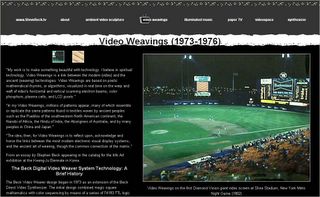
Steve Beck - Illuminated Music
"The composition itself was considered a form of “visual jazz” by Beck, in that the basic visual structure of the work remained in place from performance to performance, yet subject to the visual themes and variations changing in each interpretation. Two of the Illuminated Music performances by Beck and Jepson were broadcast nationally on the PBS network as part of the “Videospace Electronic Notebooks” series produced by the National Center for Experiments in Television.
"Illuminated Music" first emerged as both a neologism and a live performance on KQED TV in San Francisco on May 19, 1972, when Beck preformed live, on the air with his Beck Direct Video Synthesizer to the jazz music "Like It Is" by the master of jazz, Brother Yusef Lateef. Beck was then a video artist in residence with the National Center for Experiments in Television, which produced this event.
The performance took place in real time on a weekly TV program called SCAN, hosted by journalist Joe Russin. The show followed the nightly "Newsroom" program on KQED at 7:30 PM on a Friday evening. The artist was able to control 50,000 watts of effective radiated TV transmission power through his fingertips and hands using the Beck Direct Video Synthesizer. No television or video camera images were involved, to the chagrin of the NABET technical union, which nevertheless let the show go on.
This was the only known live television ever broadcast from a Direct Video Synthesizer, (or any other video synthesizer) and during the broadcast, the station's telephone switchboard "lit up like a Christmas Tree," according to KQED.
A precursor to what later became known as music video, "Illuminated Music" interpreted the music in personal, nonobjective, cinematic visual forms. The work was inspired by Beck's artistic heroes, such as German experimental film pioneer Oscar Fishinger, kinetic light artist Thomas Wilfred and his Lumias, and experimental filmmakers John and James Whitney. Another influence was Jordan Belson, with whom Beck collaborated and co-created an electronic videofilm entitled "CYCLES" in 1974. Beck's had envisioned an all-night television channel with music and images similar to what he had created for "Illuminated Music."
Source: http://www.stevebeck.tv/ill.htm
see also his works: video weavings. ambient video sculpture, videospace, paperTV, Beck Direct Video Synthesiser
 Video excerpt of Video Weavings
Video excerpt of Video Weavings"Inspired by the analogy between weaving (vertical warp threads traversed by horizontal weft threads) and the construction of the television image (vertical and horizontal scans of an electron gun), Stephen Beck built the Video Weaver in 1974, and produced Video Weavings in 1976. The patterns in this tape are based on sequences of colors in dynamic mathematical progressions, inspired by non-representational Islamic art. Beck was also intrigued with the problem of synthesizing aspects of human perception. Arriving at video through music, Beck had moved from jazz to electronic music and then to electronic instrument building. For many of the early video tool designers, audio synthesizers served as important models. Beck developed his first video instrument, the Direct Video Synthesizer, in 1970 during his residency with the National Center for Experiments in Television (NCET) in San Francisco." Source: http://www.vdb.org/smackn.acgi$tapedetail?VIDEOWEAVI

Steve Becks - Video Weavings
Other links
Tate Exhibition: Kinetic Color - Nov 2008
Article: Stephen Beck's vsynths
Becks Presentation on /a>: Stephen Beck, Artist & Inventor, Berkeley - Photons, Electrons, Icons and Phonons: Materials and Makings of Pre- and Post-Digital Art